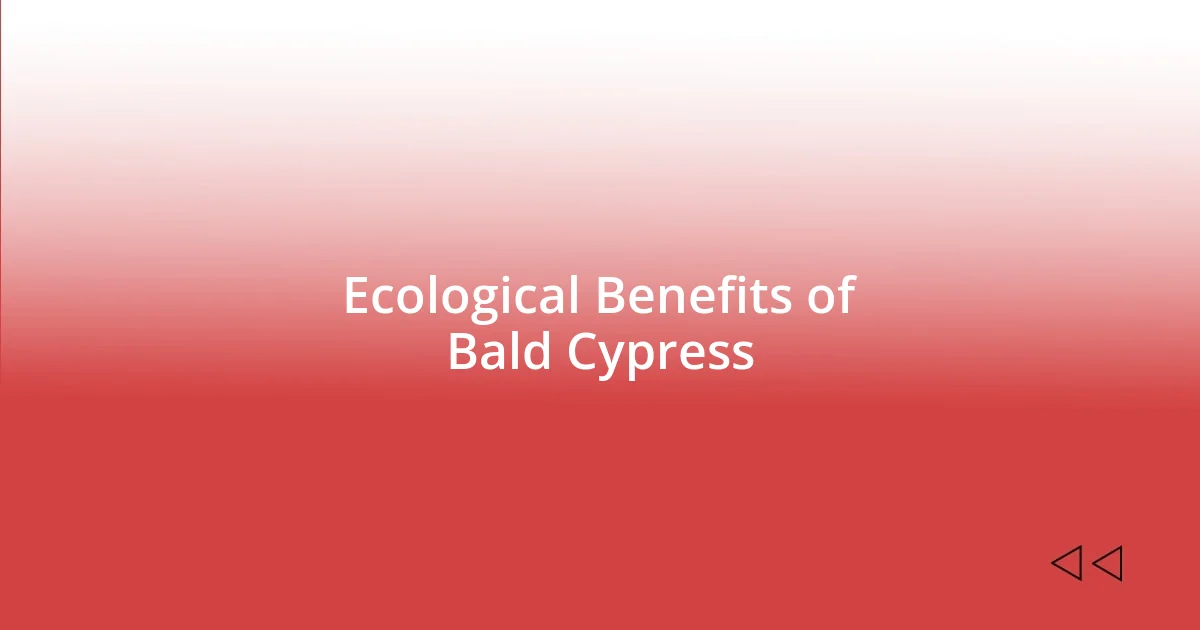Key takeaways:
- Bald Cypress trees, known for their stunning fall colors and longevity, thrive in swampy environments and play a crucial role in their ecosystems.
- The wood of Bald Cypress is durable and decay-resistant, historically used for construction, furniture, and musical instruments.
- These trees provide essential ecological benefits, including habitat for wildlife, flood control, and carbon sequestration, making them vital for environmental health.

Bald Cypress Overview
The Bald Cypress, known scientifically as Taxodium distichum, is a remarkable tree that thrives in swampy environments, exhibiting a unique adaptation to its wetland habitat. I remember my first glimpse of a grove of these majestic trees, their knobby knees emerging from the water like ancient giants watching over the landscape. Isn’t it fascinating how nature equips each species with traits that help them endure their surroundings?
These trees can live for over a thousand years, making them a living connection to eras long past. Just imagine standing next to a tree that has witnessed centuries of history; it gives you a sense of awe and respect for the resilience of life. Reflecting on this, I can’t help but wonder: what stories could these cypress trees tell if they could speak?
What truly sets the Bald Cypress apart are its stunning fall colors. When the leaves turn a vibrant rusty orange before dropping, the transformation creates a breathtaking scene that feels almost magical. I find myself captivated by this seasonal shift, pondering how such beauty can emerge from the cycles of change. Don’t you think that nature’s ability to reinvent itself is both humbling and inspiring?

Historical Significance of Bald Cypress
Bald Cypress trees hold deep historical significance, especially in the southeastern United States. I recall visiting a plantation where ancient cypress trees stood sentinel over the land, remnants of an era when they were revered not just for their beauty, but for their practical uses. The wood of the Bald Cypress is naturally resistant to decay, which historically made it a favored choice for building structures, from canoes to churches, solidifying its role in the lives of those who inhabited its regions.
- Essential for shipbuilding and construction in the 18th and 19th centuries
- Played a crucial role in the timber industry, particularly in the Gulf Coast
- Used by Indigenous cultures for crafting tools and ceremonial items
- Symbolizes resilience and longevity in various cultures, representing strength and endurance
Each cypress tree feels like a witness to trials and triumphs of past generations, and I often find myself reflecting on how these trees continue to thrive amid whispers of history. It’s humbling to acknowledge how they’ve been part of our collective narrative, from providing shelter to forming the backdrop of countless stories in folklore and community life. Wouldn’t it be fascinating to imagine the tales they’d share if only we could listen?

Ecological Benefits of Bald Cypress
The Bald Cypress not only enchants us with its beauty, but it also plays a crucial role in its ecosystem. I’ve often observed how these majestic trees provide significant habitat for diverse wildlife. For example, their knobby roots create sheltered areas for fish, while their canopy offers refuge for various bird species. It’s heartwarming to witness the life that thrives around them, reminding us of the interconnectedness of nature.
These trees also contribute to water quality and flood control in their environments. Reflecting on a rainy day spent by a cypress swamp, I noticed how the trees absorbed excess water, acting as natural sponges. This ability to moderate water levels helps mitigate flooding, a crucial benefit for surrounding communities. Have you ever thought about how trees like the Bald Cypress are nature’s silent guardians?
Moreover, Bald Cypress trees are vital for carbon sequestration. Their massive trunks store significant amounts of carbon dioxide, which is essential in combating climate change. I remember a moment standing among these giants, thinking about the role they play in cleansing our air and improving our planet’s health. Every tree we lose contributes to our climate problems, but trees like these actively work against it.
| Benefit | Description |
|---|---|
| Habitat Provision | Supports various wildlife species with its unique structure and shelter. |
| Flood Control | Stabilizes water levels, effectively reducing the risk of flooding in surrounding areas. |
| Carbon Sequestration | Absorbs carbon dioxide, helping to mitigate climate change through its large biomass. |

Growth Requirements for Bald Cypress
Bald Cypress trees thrive in wetland environments, which is where they truly find their strength. I often recall my trips to the swamps where these trees flourish, their roots entwined in the waterlogged soil. Their preference for moist, acidic conditions not only nurtures their growth but also contributes to their striking appearance with those characteristic buttressed trunks.
Interestingly, while they love water, Bald Cypress can also adapt to drier conditions once established. I remember visiting a park where I was surprised to see a cluster of these trees thriving on slightly elevated ground, far from standing water. This adaptability showcases their resilience, emphasizing how environments can shape growth patterns in surprising ways.
For optimal growth, Bald Cypress requires full sun exposure. I can vividly recall standing under their lush canopies, feeling the sunlight filter through and illuminate the vibrant green foliage. Without adequate sunlight, these trees might not reach their full height or display the impressive growth characteristics for which they are known. Have you ever considered how much energy these giants absorb from the sun to reach their awe-inspiring heights? It’s a beautiful reminder of nature’s balance.

Uses of Bald Cypress Wood
The wood of the Bald Cypress is revered for its durability and resistance to decay, making it an ideal choice for outdoor applications. I distinctly remember my grandfather’s old wooden dock made from this timber. Even after years of exposure to the elements, it stood firm and strong, a testament to the material’s longevity. Isn’t it fascinating how something so sturdy can come from such a beautiful tree?
When it comes to crafting, Bald Cypress wood shines in making furniture and flooring. I once visited a local artisan’s workshop where he proudly showcased his handcrafted tables made from this wood. The rich grain and warm hue added charm to each piece, and I couldn’t help but admire how it breathed life into the interiors. Have you ever sat in a room with furniture that just felt right? Bald Cypress wood has a way of creating that inviting atmosphere.
Additionally, the cypress wood is widely used in musical instruments, especially in acoustics. One of my fondest memories is attending a concert where the guitarist played a cypress-bodied guitar. The sound was rich and resonant, making each note linger in the air. It’s incredible how the choice of material can impact the music we enjoy. Could this be the reason why so many musicians cherish their cypress instruments? The wood truly has a musical soul of its own.













